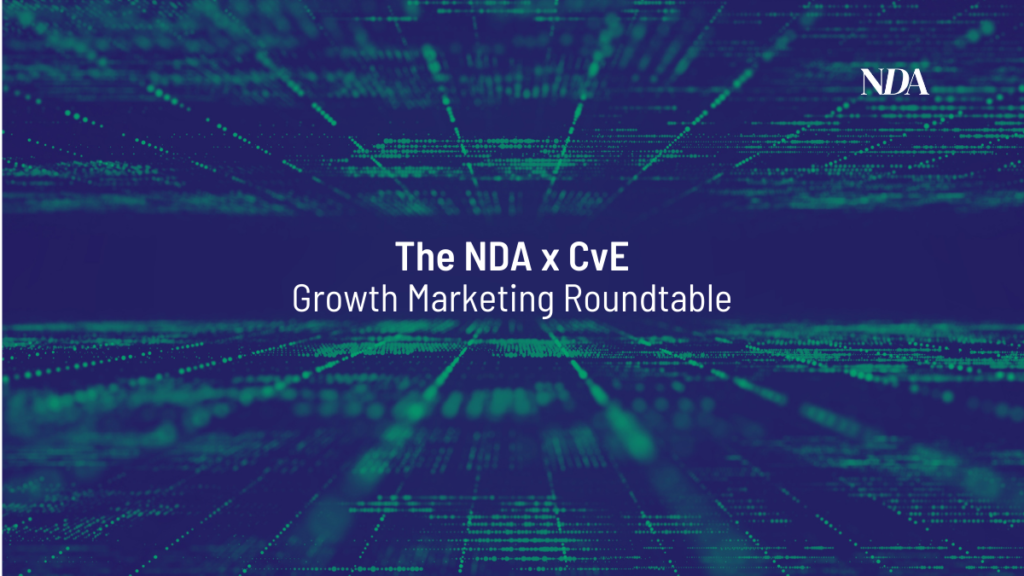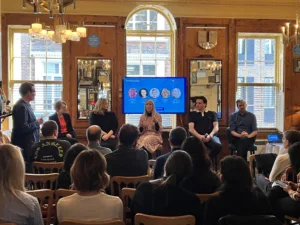The post-pandemic increase in ecommerce spending (combined with incoming restrictions to popular online tracking methods) means brands are more interested than ever in acquiring and analyzing audience data for insights to fuel growth. However, for many FMCG brands, the data they really need is often the property of their retailer partners, making it difficult to access.
New Digital Age (NDA), in association with marketing transformation consultancy CvE (ControlVExposed) recently hosted a roundtable of senior professionals and subject experts on the subject of ‘growth marketing’ and the data challenges it poses for brands. (The first article resulting from this event is here.)
NDA editor Justin Pearse chaired the discussion and was joined by: Paul Frampton, Global President, and Aidan Mark, Global Director, Performance Strategy, CvE; Benazir Barlet-Batada, Marketing Director Confectionary UK&I, Mondelez; Seb Bardin, Head of Ecommerce Marketing, Unilever; Rory McEntee, Brand & Marketing Director, Gymbox; Adam Wright, Head of Digital, Beiersdrof; Gareth Turner, Head of Marketing, Weetabix; and Tushar Kaul, Chief Marketing Officer, Bella and Duke.
Weetabix’s Turner spelled out the problem for FMCG brand marketers: “We don’t always have the data we need. The big retailers have it. The truth is, next week, I won’t know the result of this week’s work. We don’t have that transparency of data to know what the short term impact of our work is. That’s why we have to look at longer-term monthly and quarterly data, or ROI based on 12/18/24 months of sales impact. How does one become more of a growth marketer without access to short-term data?”
Data directions
Wright, who manages digital marketing activity for brands including Nivea and Nivea Men at Beiersdorf, outlined his organisation’s response to the data challenge. He said: “ It’s a problem for all FMCG brands who make the majority of their sales through traditional retail channels. Over the past 18 months or so, a lot of my focus has been on establishing a first-party data model that will act as a foundation for us in the future.
“One of our biggest projects recently was launching our own direct-to-consumer (DTC) store online and getting the data infrastructure we needed in place. DTC, to be honest, is never going to be a huge sales driver for us, but it’s a massive opportunity for us to then be able to get direct firsthand access to customer data.”
CvE’s Frampton Calero agreed that FMCG brands can benefit from establishing a DTC operation of their own. He said: “It’s not about suddenly doing 50% of your sales through your own DTC platform, it’s about owning the data, which is the first point in a journey. You can then start to fuse your first-party data with other very rich data sets that are out there and use those insights to connect some of those top of the funnel metrics with the bottom of the funnel and provide better experiences for customers in the middle.”
Bardin of FMCG giant Unilever believes that when it comes to first-party data acquisition and deployment, brands need to gather data from the very beginning of a customer-relationship, pre-engagement, before the customer even has a need for your product. He said: “When it comes to privacy, it’s not about what we are able to do, but what we should do. Privacy is a fundamental human right. At Unilever, there is no place for invading privacy, it doesn’t align with our values nor does it give any competitive advantage. In fact, the potential consequences are damaging.
We have a regular feature with one of our publisher partners where we provide advice and cleaning tips without mentioning our brands. That allows us to learn about customer needs, to nurture this data that we’re collecting, before exposing the consumer to a product via our DTC or retail channels.”
Data and brand experience
McEntee of online fitness brand Gymbox spoke of how his organisation faces an opposite problem to most FMCG brands in that they have “too much” first-party data! He said: “Our big challenge with customer data is that our audience is broad. People who are into boxing and people who do yoga are usually very different, so trying to extrapolate the data and understand the different levers that will work with those different audiences is challenging. We probably have 70 different paid social adverts going on at any one time, constantly learning, testing and tweaking as we go.”
For household confectionary brands such as Cadbury’s, heavily dependent on the physical availability of their product via retailers, social media may provide a key to unlock more customer insights via consented first-party data, according to Barlet-Batada. She said: “Our goal is to deliver a more engaging brand experience regardless of what stage of the funnel the consumer is in, simultaneously driving both brand equity and revenue. The evolution of social media platforms has really blurred the line between commerce and entertainment, particularly for Gen Z audiences and we see huge potential here”.
Kaul of pet food subscription brand Bella and Duke told of how the brand had spurned approaches from supermarkets to stock their products, mainly to preserve the data relationship they have with their customers and to maintain the bespoke nature of their produce. He said: “Our growth approach is to build our community. We don’t have social media managers or community managers, we let the conversation happen organically and learn from that. Sometimes that means seeing competitors’ products being recommended on our platform, in our group, but we accept it and, as a result, learn that we don’t have the best product in the market for that specific range. This information feeds straight into our New Product Development activity.”









